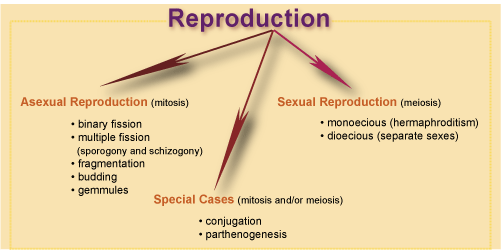Asexual reproduction refers to multiplying through mitosis: one cell producing two identical genetic copies of itself. Many protists (eg. flagellates, amoebas) reproduce primarily through mitotic division. The cleavage plane can occur parallel to the long axis (longitudinal binary fission) or the plane can be perpendicular to the long axis (transverse binary fission). Click here for examples.
Another form of asexual reproduction, multiple fission, occurs in some amoebas and in Apicomplexa. This type of division is characterized by repeated organelle and nuclear divisions, followed by cytokinesis, The result is simultaneous production of enormous numbers of new cells. Plasmodium, the organism that causes malaria, alternates asexual (multiple fission) and sexual phases in its life cycle.
Conjugation, a specialized sexual mechanism, occurs in some ciliates. Two mating types line up side-by-side and remain attached for several hours. During the pairing process each individual undergoes meiosis to produce haploid pro-nuclei, which are exchanged with its partner. Following this exchange of genetic material, the two organisms separate and then usually divide mitotically. Note that in conjugation there are no sperm or eggs produced, yet new genetic combinations do appear because of meiosis.
